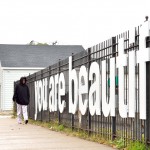With Englewood set to welcome a Whole Foods on 63rd and Halsted and an adjacent Starbucks this year, the South Side neighborhood is battling stereotypes that it’s an unlikely choice for expansion.
“It was almost a national joke, Whole Foods coming into Englewood,” says Jim Harbin, program director at the Greater Englewood Community Development Corporation. “That really stunned some people, initially.”
Although residents say they are eager to see more jobs and fresh produce in a neighborhood considered a food desert – a geographic area where healthy food is hard to find – Harbin says the retail influx is just one more step in a process of community revitalization that started long before either chain announced expansion plans.
“Contrary to popular belief, Englewood is not one giant, poor neighborhood,” Harbin says. “There’s a demographic of people who are economically challenged, but there’s a middle-income demographic as well. A lot of retailers are starting to understand that there’s some economic power no matter where you live, including Englewood.”
Harbin, a lifelong Englewood resident, tells the history of a black population moving from Chicago’s historic Black Belt into the once-prosperous Englewood by the late-’50s construction of the Dan Ryan Expressway. Realtors engaged in block-busting, urging white families to leave their homes for fear of incoming black neighbors, then selling those vacated homes to black buyers at inflated prices.
Block-busting realtors and slum landlords kicked into motion a cycle of economic disadvantage that strongly impacted the neighborhood. In the past 25 years, the population of Greater Englewood has shrunk from roughly 150,000 to 60,000. A 2012 City of Chicago Green Healthy Neighborhoods study reported that an amount in excess of $127 million in retail dollars left Greater Englewood that year.
While many Englewood residents are working to strengthen their community, media focus on violent crime means their efforts rarely get the coverage they deserve, says St. Bernard Hospital spokeswoman Diahann Sinclair.
“There’s a lot of good things going on in the neighborhood and a lot of good work,” Sinclair says. “But it’s hard to get that covered in the mainstream media because it’s always overshadowed by the kind of things that grab headlines.”
In the early 2000s, the 111-year-old hospital worked with the city of Chicago to build a 70-unit affordable housing development at 64th Street and the Dan Ryan Expressway for which first-time home buyers received purchasing subsidies through the New Homes for Chicago Program.
Also working to strengthen the community is Kusanya Cafe on West 69th Street, a non-profit coffee house that doubles as a performance space for local artists.
“The goal was for Englewood residents to be able to empower each other,” says Phil Sipka, Kusanya’s executive director. “And for that you need a gathering space.”
According to Sipka, Kusanya was founded in 2012 by residents who wanted to attend cultural events in their own neighborhood instead of traveling to Hyde Park or downtown. The cafe has hosted resident-led open mic nights, yoga classes and a black women’s discussion group, among other events.
Kusanya aims to attract an economically diverse customer base, says Sipka, whose 69th and Peoria neighbors include business owners as well as former Section 8 residents. Crucial to this process is Kusanya’s apprentice program, where budding entrepreneurs from Englewood and the surrounding area get business mentorship and support while working at the cafe.
“Phil’s been helping me with marketing, finding other mentors, even packaging and taxes,” says Kusanya apprentice Arica Morgan, 23, whose startup Salubria Holistic Beauty Products launched at the cafe in May 2015. “I’m about to launch full-time, and I feel like I’ll have a connection to Kusanya always.”
Hanging on Kusanya’s wall are framed prints by local photographer Tonika Johnson: eye-poppingly colorful photos of Englewood children playing, a father pushing his child in a bucket swing, a team of young football players. Johnson is one of many local artists who have been showcased by the Englewood Community Cultural Planning Council, another mainstay of neighborhood revitalization.
“I think arts and culture is going to be a part of the thread of community development,” says council member Asiaha Butler. “I think more people are looking for more opportunities to find places for their own creative expression as well as places where they can embrace and talk about the arts.”
Butler helps coordinate So Fresh Saturdays, a summer program where Englewood residents “take over Hamilton Park in the name of peace.” Attendees enjoy musical performances, displays of work by local artists and discussion about social and economic empowerment.
Alisa Inez, co-founder of the Englewood International Film Festival, agrees with Butler when it comes to the role of the arts in community development. Inez hopes to expand Chicagoans’ awareness of what Englewood has to offer.
Art and culture in Englewood “is beautiful for those who know about it, but more and more people need to know,” Inez says. “Then that art and culture can be enjoyed by more and perhaps even become financially fruitful for the neighborhood.”
So far, Inez has been successful in her quest. The 2015 festival attracted an audience of roughly 500 and screened films from Germany, South Korea and Iraq alongside Chicago films. A career day event brought actors, filmmakers and screenwriters to K-12 classrooms throughout Englewood.
The festival made use of Kennedy-King College’s spacious auditorium to screen “I Ain’t Scared of You,” a documentary about comedian and Englewood native Bernie Mac. Steps away from the auditorium stands Kennedy-King’s Washburne Culinary and Hospitality Institute, a 75-year-old culinary school that operates Sikia, a gourmet restaurant that offers three-course meals for as low as $8.

Washburne Dean Kristopher Murray says food has played a key role in bringing Englewood residents together, and he is optimistic about Sikia’s potential to effect community change by training local chefs.
“Change really has to do with food, from agriculture to retail,” Murray says. “So I think we’re just playing our part in that as a culinary institution.”
For residents like Harbin who are aware of what Englewood has to offer, stereotypes portraying the neighborhood as too dangerous for retail investment are especially unwelcome.
“There’s about 60,000 people here, yet most of the stories you hear are about 200 of them,” Harbin says. “Those 59,800 are doing some remarkable things, but we only hear about the 200 that are not.”










